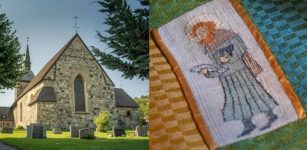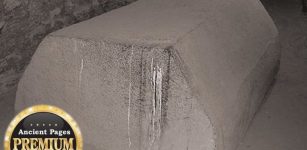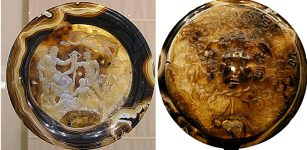Sarmizegetusa And Its Andesite Sun Artifact Similar To The Mayan Calendar
A. Sutherland - AncientPages.com - Sarmizegetusa (today Gradistea Muncelului) County was the capital of pre-Roman Dacia, located in the Orastie Mountains, in present-day Romania. Before the wars with the Roman Empire, Sarmizegetusa was also the most important military, religious and political center of the Dacians.
It's a complex of sanctuaries situated on a cliff at an altitude of 1200 m, with a leading, large round sanctuary and the so-called "andesite sun" artifact.
The sanctuaries were located on a terrace, which had been linked previously mentioned gate by a paved road. Today, it's unknown if Sarmizegetusa had seven or eight quadrilateral sanctuaries because the Romans destroyed them
The fortress, a strategic center of defense, has a quadrilateral (a four-sided polygon) shape and massive stone blocks with 3m thick and approximately 4-5m high walls, constructed on five terraces, an area of almost 30,000 m².
The sacred zone of Sarmizegetusa includes several rectangular temples, and the bases of their supporting columns are still visible in regular arrays.
Perhaps the most enigmatic construction at the site is the large circular sanctuary. It consisted of a set of timber posts surrounded by a timber circle which in turn was surrounded by a low stone curb.
The andesite sun and the great round sanctuary from Sarmizegetusa Regia. (photo from The cultural Heritage of Romania, (Cluj-Napoca, 2004)
The layout of the timber settings of the Sarmizegetusa fortress bears an intriguing resemblance to the stone monument at Stonehenge in England.
We find another curious resemblance at Sarmizegetusa's most crucial artifact, "andesite sun," which was probably used as a sundial. The artifact is very similar to the famous Mayan calendar. The Dacian culture was influenced by contact with Hellenistic Greece. The sundial may have resulted from the Dacians' exposure to Hellenistic learning in geometry and astronomy. The capital of Dacia was conquered and destroyed by the Roman army in 106 AD.
Its ruins were unearthed for the first time in 1923 due to excavations under the leadership of prof. DM Teodorescu of the Department of Archaeology, the University of Cluj-Napoca, followed by other diggings until 1944.
Since it is known that Dacian culture was influenced by contact with Hellenistic Greece, the sundial may have resulted from the Dacians’ exposure to Hellenistic learning in geometry and astronomy.
Sarmizegetusa Regia also had a residential area of 3 km, with dwellings and workshops. It was a vast civil settlement with many homes, workshops, warehouses, barns, and a water reservoir.
People lived below the citadel in settlements built on artificial terraces and a system of ceramic pipes channeled running water into the nobility's residences. The archaeological inventory found at the site demonstrates that Dacian society had a relatively high standard of living.
At 100 meters to the east of the complex, there was the city and shrines of various shapes and sizes. The sanctuaries were located on a terrace linked with the gate by a paved road. Today, it's unknown if Sarmizegetusa had seven or eight quadrilateral sanctuaries because the Romans destroyed them.
The mathematical pattern of Sarmisegetusa includes all cyclopean buildings of the Dacians built at an altitude of 1,045m). The line of the North coincides precisely with the arrow of the so-called Andesite Sun.
At the ancient site of Sarmizegetusa, we encounter evidence of our ancestors' knowledge of cosmogonical topography, divine geometry, and cosmic harmony and several artifacts offering proof that the Dacians were an advanced society.
The Dacians were skilled metalworkers. Excavations conducted in the area revealed tools such as meter-long tongs, hammers, and anvils used to make 400 metallic artifacts — scythes, sickles, hoes, rakes, picks, pruning hooks, knives, plowshares, and carpenters' tools.
Decebalus’ suicide, from Trajan’s Column (Scene CXLV)
However, among the most important finds unearthed at the site, is a medical kit, in a brassbound wooden box with an iron handle, containing a scalpel, tweezers, powdered pumice and miniature pots for pharmaceuticals, and a large funerary vessel (0.6 m) high and 41 in (1 m) across, bearing an inscription in the Roman alphabet: DECEBAL PER SCORILO, i.e. 'Decebalus, son (cf. Latin puer) of Scorilus'.
The Decebalus per Scorilo inscription. The Decebalus inscription was stamped on a huge vase twenty-four inches (0.6 meters) high and forty-one inches (1 meter) across. It is stamped in mirror-writing, in the Latin alphabet. image source
Decebal (Decebalus) (ruled 87-106) was the last king of Dacia. The Romans defeated the Dacians in the Battle of Tapae in 88; they set fire to several towns and moved towards Sarmizegetusa, the kingdom's capital.
The Romans laid siege to the town and cut Sarmizegetusa's water supply. The Dacians eventually surrendered, and Decebalus committed suicide. Dacia became a Roman province.
Dacian Fortress Sarmizegetusa is on the UNESCO World Heritage list.
Written by – A. Sutherland - AncientPages.com Senior Staff Writer
Copyright © AncientPages.com All rights reserved. This material may not be published, broadcast, rewritten or redistributed in whole or part without the express written permission of AncientPages.com
Expand for referencesReferences:
I. Grumeza, "Dacia: Land of Transylvania, Cornerstone of Ancient Eastern Europe"
More From Ancient Pages
-
 Mysterious Sea People: Many Theories But Their Origin Is still Unknown
Civilizations | Feb 24, 2015
Mysterious Sea People: Many Theories But Their Origin Is still Unknown
Civilizations | Feb 24, 2015 -
 Amazing Photos Of Ancient Ruins Hidden Under Thessaloniki Metro Revealed By Archaeologists
Archaeology | Jan 9, 2023
Amazing Photos Of Ancient Ruins Hidden Under Thessaloniki Metro Revealed By Archaeologists
Archaeology | Jan 9, 2023 -
 Raven Mocker And Cannibal Body Snatchers In Cherokee Mythology
Featured Stories | Jun 13, 2019
Raven Mocker And Cannibal Body Snatchers In Cherokee Mythology
Featured Stories | Jun 13, 2019 -
 Mystery Of Ancient Beehive Tombs Around The World
Featured Stories | Feb 28, 2016
Mystery Of Ancient Beehive Tombs Around The World
Featured Stories | Feb 28, 2016 -
 Saint Botvid – Viking Who Was Killed By A Slave He Granted Freedom
Featured Stories | Apr 10, 2023
Saint Botvid – Viking Who Was Killed By A Slave He Granted Freedom
Featured Stories | Apr 10, 2023 -
 Stone Age Friendship Ornaments Examined By Scientists
Archaeology | Apr 25, 2022
Stone Age Friendship Ornaments Examined By Scientists
Archaeology | Apr 25, 2022 -
 1,000-Year-Old Viking Weaver’s Sword Reveals Its Secrets
Archaeology | Apr 17, 2022
1,000-Year-Old Viking Weaver’s Sword Reveals Its Secrets
Archaeology | Apr 17, 2022 -
 Historian Suggests Jack The Ripper Fled To Australia Where He Met His End
Archaeology | Sep 10, 2016
Historian Suggests Jack The Ripper Fled To Australia Where He Met His End
Archaeology | Sep 10, 2016 -
 Viklaumadonna Hides A Thousands-Year-Old Secret
Artifacts | Jan 5, 2020
Viklaumadonna Hides A Thousands-Year-Old Secret
Artifacts | Jan 5, 2020 -
 Mystery Of Ancient Sarcophagi In Egypt
Featured Stories | Aug 26, 2015
Mystery Of Ancient Sarcophagi In Egypt
Featured Stories | Aug 26, 2015 -
 2,550 Submerged Wooden Objects Recovered From The Templo Mayor Of Tenochtitlan
Archaeology | Jun 25, 2022
2,550 Submerged Wooden Objects Recovered From The Templo Mayor Of Tenochtitlan
Archaeology | Jun 25, 2022 -
 Alux: Little Mythical Troublemaker And Guardian Of Corn Fields In Mayan Folklore
Featured Stories | Jun 11, 2019
Alux: Little Mythical Troublemaker And Guardian Of Corn Fields In Mayan Folklore
Featured Stories | Jun 11, 2019 -
 Recreation Of Cleopatra’s Ancient Perfume
Archaeology | Aug 26, 2019
Recreation Of Cleopatra’s Ancient Perfume
Archaeology | Aug 26, 2019 -
 Tazza Farnese (Farnese Cup) – Mysterious, Never Explained And Debated Ancient Gemstone
Artifacts | Aug 31, 2022
Tazza Farnese (Farnese Cup) – Mysterious, Never Explained And Debated Ancient Gemstone
Artifacts | Aug 31, 2022 -
 Incredible Ancient Roman ‘Service Station’ With Hundreds Of Artifacts And Dozens Bodies Found In Hertfordshire, UK
Archaeology | May 12, 2022
Incredible Ancient Roman ‘Service Station’ With Hundreds Of Artifacts And Dozens Bodies Found In Hertfordshire, UK
Archaeology | May 12, 2022 -
 Focus On Turkana Boy: Modern Human Body Evolved More Recently Than Once Believed
Archaeology | Jul 8, 2020
Focus On Turkana Boy: Modern Human Body Evolved More Recently Than Once Believed
Archaeology | Jul 8, 2020 -
 Acta Diurna: World’s First Newspaper Appeared In 131 B.C
Ancient History Facts | Jun 10, 2019
Acta Diurna: World’s First Newspaper Appeared In 131 B.C
Ancient History Facts | Jun 10, 2019 -
 Ten Inscriptions Related To Sargon Unearthed At Ancient Assyrian Site In Iraq’s Kurdistan Region
Archaeology | Jan 20, 2020
Ten Inscriptions Related To Sargon Unearthed At Ancient Assyrian Site In Iraq’s Kurdistan Region
Archaeology | Jan 20, 2020 -
 Are Relics In Santi Apostoli Church Really The Remains Of St. James And St. Philip?
Fossils | Feb 8, 2021
Are Relics In Santi Apostoli Church Really The Remains Of St. James And St. Philip?
Fossils | Feb 8, 2021 -
 Lusatian Culture: Ancient Traders Of Central Europe Built Strongly Fortified Settlements To Withstand Scythian Attacks
Civilizations | Jan 27, 2024
Lusatian Culture: Ancient Traders Of Central Europe Built Strongly Fortified Settlements To Withstand Scythian Attacks
Civilizations | Jan 27, 2024






